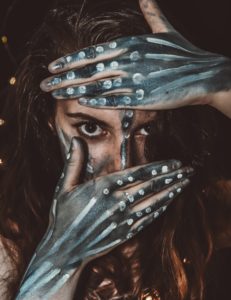My partner and I have been watching Lie To Me, a television series that ran on Fox from 2009 to 2011. The show is based on the work of Dr. Paul Ekman, the world’s greatest expert on facial expression.
I am absolutely fascinated.
All my life I’ve been extremely aware of body language and what I’ve always called the “energy” of the people around me. I’ve frequently had the experience of picking up the hidden emotions of others and taking on responsibility for them, a result of ineffective boundaries. When I was trained in emotional intelligence I cleaned up my poor boundaries and many other destructive habits. I also began to openly and unapologetically trust myself after a lifetime of cognitive dissonance caused by the difference between words and nonverbal cues from others.
Now, at last, I have real world validation for the way I can sometimes “read” others. It’s not magic, and I’m not a freak, a fantasist or crazy. Science now recognizes the universality of human facial expressions for basic emotions (fear, surprise, contempt, happiness, sadness, disgust, shame), and technology allows us to slow down video footage and capture microexpressions, which occur in much less than a second, as we speak and interact with others.
Our words can lie, but Dr. Ekman’s work reveals our bodies give away our emotional experience in all kinds of ways of which we’re not even conscious. The way we hold our hands, a slight shoulder shrug, the way we move our heads, how we direct our gaze and small, fleeting expressions passing across our faces with the help of 42 complex muscles can contradict our words.
We know some people have a great deal of difficulty reading and interpreting body language and subtle cues, while others are skilled at it. Paul Ekman’s work and research makes it possible for anyone to consciously learn how to detect emotional deception. Every episode of Lie To Me incorporates not only a story line told by actors, but also footage from real people — politicians, leaders and other famous and infamous folks — displaying exactly the same facial expression or body movement. It’s amazing.
Some people are difficult to read. I’ve worked hard to develop a stone face and have often been told I’m opaque. My oldest son is extremely provocative, and my expressionless countenance stood me in good stead when he was a teenager and woke me in the middle of the night to tell me he was going to ski naked at midnight with a girl in one hand and a bottle of whiskey in the other. Any show of outrage or upset only egged him on, so I learned to control myself. I’ve also had some exposure to narcissists and other Cluster B people, who feed on emotional energy, and I know the best way to deal with them is to become a grey rock, that is to be so completely flat, uninteresting and uninterested that they move on, a technique far more effective than trying to get rid of them directly. Yet even though I may be harder to read than average, I know my body language gives me away every time, or would to a trained observer.
(Fortunately, my teenage sons were not trained observers. Let us be thankful for small mercies.)
Sedating substances and Botox injections can interfere with or blunt muscle movement and smooth out microexpressions, but eventually we all give our truth and lies away. We can’t help it. Microexpressions and body language are often totally unconscious on our part.
I’ve been told I have an intense gaze that can make others feel uncomfortable. I suspect this is a function of the focus and presence necessary to evaluate how the people around me present themselves as I compare what they say with what their expressions and bodies tell me. If I feel confused or receive a mixed message, I always go with body language. Words lie too easily and too frequently. We lie to ourselves and we lie to each other. When I experience cognitive dissonance as I observe and interact with others, now I no longer tell myself I’m making things up. Even more importantly, I don’t allow other people to make me feel bad and wrong. Nobody likes to have their cover blown, and someone with things to hide is naturally not going to appreciate feeling exposed. Rage, denial, projection, gaslighting and other abusive behavior can all be effective distractions from the truth.
A lie comes with a cost. The truth may come with a cost as well. We navigate our lives between the two, making the best choices we can. I have no desire whatsoever to uncover the secrets and lies of others, but I am interested in being able to evaluate if there are secrets and lies. I don’t believe we owe others 100% of our emotional truth, but every healthy relationship and connection requires some level of trust, and I don’t want to be with people I can’t trust. I think of mixed messages as a red flag.
It’s amazing to learn, after all these years of mysteriously and often uncomfortably picking up more information from others than I ever wanted to know, that inconsistency is a red flag. Words that are incongruent with facial expressions and body language are untrustworthy. My ability to recognize concealed emotions is not hateful or crazy.
Frequently we don’t seek to deceive others as much as we wish to deceive ourselves. The lies we tell ourselves are perhaps the most powerful of all, and we protect those kind of lies the most ferociously.
It’s important to understand recognizing the presence of a lie does not mean we know the substance of the lie or why it’s being told. As a writer, I find that why infinitely interesting in its possibilities. What kinds of things do we conceal? What motivates us to do so? What are the consequences of our various lies, great and small, to ourselves and to others? How do our bodies unconsciously communicate our emotional deception? If we spot emotional deception in someone we’re close to, what do we do with that information? What kinds of lies are terminal in relationships, and what kinds survivable? How do we forgive ourselves and others for emotional deception?
The looming presence of social media in our culture means many of our daily interactions, perhaps most, are not face to face, which greatly diminishes the complexity and depth of human communication and makes emotional deception easy. Body language is invisible. Tone, pitch and other verbal clues and idiosyncrasies are unheard. We use sanitized little emojis to represent our meaning, or at least to represent what we want others to believe our meaning is.
Paul Ekman has written several books I’m looking forward to exploring, and one can take online classes and learn more. I intend to learn a lot more.
All content on this site ©2018
Jennifer Rose
except where otherwise noted
© 2018 – 2022, Jenny Rose. All rights reserved.




